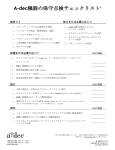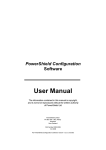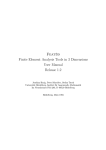Download BFSAI-IC OpenMP Implementation: User's guide Contents
Transcript
BFSAI-IC OpenMP Implementation: User’s guide
Carlo Janna, Massimiliano Ferronato, Nicola Castelletto
Dept. Mathematical Methods and Models for Scientific Applications
University of Padova, Padova, Italy
E-mail: {janna,ferronat,castel}@dmsa.unipd.it
January, 2011
Contents
1 Theoretical background
2
2 The BFSAI-IC OpenMP Implementation code
2.1 Input data . . . . . . . . . . . . . . . . . . . . . . . . . . . . . . .
2.2 Output results . . . . . . . . . . . . . . . . . . . . . . . . . . . .
2
6
7
3 Numerical examples
8
4 Copyright
11
1
1
Theoretical background
The objective of the BFSAI-IC OpenMP Implementation code is to solve a
symmetric positive definite (SPD) linear system:
Ax = b
(1)
where A ∈ Rn×n and x, b ∈ Rn , with the aid of the Preconditioned Conjugate
Gradient (PCG) algorithm. The BFSAI-IC preconditioner:
M −1 = W T W = F T JL−T JL−1 F
(2)
consists of:
• a unitary lower triangular matrix F ∈ WSBL such that kD − F LkF is
minimum for an arbitrary block diagonal matrix D, with L the exact
lower Cholesky factor of A and WSBL the set of matrices with non-zero
pattern SBL ;
• a lower triangular matrix JL containing the lower Incomplete Cholesky
factors of the nb diagonal blocks of F AF T .
The non-zero pattern SBL is diagonal for the nb diagonal blocks and uses the
lower non-zero pattern of Ak for the off-block diagonal part. The density of the
BFSAI-IC preconditioner is controlled by a set of user-specified parameters:
1. ρB : maximum allowable number of non-zeroes for each row of any diagonal
block of F AF T in excess of the corresponding row of A;
2. δ: tolerance below which an entry in the i-th row of F is dropped relative
to the 2-norm of the same row;
3. ρL : maximum allowable number of non-zeroes for each row of the lower
triangular factor of any diagonal block of F AF T in excess of the corresponding row of F AF T ;
4. τL : tolerance below which an entry in the i-th row of JL is dropped relative
to the 2-norm of the same row.
The details of the computation of F and JL along with the overall theoretical
background are provided in the paper:
Carlo Janna, Massimiliano Ferronato and Giuseppe Gambolati. A Block FSAIILU parallel preconditioner for symmetric positive definite linear systems. SIAM
J. Sci. Comput., 32:2468-2484, 2010.
2
The BFSAI-IC OpenMP Implementation code
BFSAI-IC OpenMP Implementation is coded in Fortran90 using integer,
logical, character and double precision real variables. The main program source
file is test bfsai.f90. The matrices A and F are stored in CSR format, while
each diagonal block of JL is stored in MSSR format. The code structure is the
following:
2
1. link to the Input/Output units (subroutine openio);
2. reading and storage of matrix A (subroutine mk CSRMAT and readmat);
3. reading and storage of the right-hand side vector b;
4. reading of the Input parameters;
5. construction of the parallel data structure to handle A, F and JL with np
processors (subroutine mk OMPDTSTR);
6. estimate of the maximum number of non-zeroes stored in F and JL ;
7. allocation of the BFSAI-IC data structure (subroutine mk BFSAI);
8. BFSAI-IC computation (subroutine compute BFSAI);
9. allocation of the PCG data structure (subroutine mk BFSAI CG);
10. solution of the linear system Ax = b (subroutine PCG solv);
11. printing of the Output results.
The BFSAI-IC OpenMP Implementation package is designed to be easily
linked to other user’s codes. The following classes are defined:
• class OMPDTSTR: variables for the parallel handling of matrices and vectors;
• class CSRMAT: variables for the CSR matrix storage;
• class BFSAI: variables for the BFSAI-IC preconditioner;
• class BFSAI CG: variables for the PCG algorithm.
Dynamic allocation and deallocation of variables is allowed for using a constructor and destructor subroutine, respectively. Each class contains also a member
subroutine characterized by the prefix errchk providing detailed information
on the encountered errors.
mk OMPDTSTR is the constructor for the class OMPDTSTR variables requiring the
following exchange parameters:
• nequ (integer): matrix size;
• nproc (integer): number of processors used in the code execution;
• nbloc (integer): number of diagonal blocks;
• DTSTR var (OMPDTSTR): parallel data structure for matrix and vector
handling;
• info (integer): error code;
• blksbdv (integer array, optional): if present, a user-specified block subdivision, e.g. arising from a graph partitioning; if not present, the block
subdivision is automatic.
3
dlt OMPDTSTR is the destructor for the class OMPDTSTR variables requiring the
following exchange parameters:
• DTSTR var (OMPDTSTR): parallel data structure to be deallocated;
• info (integer): error code.
mk CSRMAT is the constructor for the class CSRMAT variables requiring the following exchange parameters:
• nn (integer): matrix size;
• nt (integer): number of non-zero matrix entries;
• mat (CSRMAT): matrix in CSR format;
• info (integer): error code.
dlt CSRMAT is the destructor for the class CSRMAT variables requiring the following exchange parameters:
• mat (CSRMAT): matrix to be deallocated;
• info (integer): error code.
mk BFSAI is the constructor for the class BFSAI variables requiring the following exchange parameters:
• DEBUG (logical): if .true. prints out F and JL ;
• SPD OPT (logical): if .true. enforces positive definiteness of JL ;
• nn (integer): size of A;
• nproc (integer): number of processors used in the code execution;
• nbloc (integer): number of diagonal blocks;
• nnz F (integer): maximum number of non-zero entries in F ;
• nnz JL (integer): maximum number of non-zero entries in JL ;
• kappa (integer): power of A used for the selection of the non-zero pattern
of F ;
• rho B (integer): parameter ρB controlling the fill-in of the diagonal blocks
of F AF T ;
• rho L (integer): parameter ρL controlling the fill-in of the diagonal blocks
of JL ;
• delta (double precision real): parameter δ controlling the dropping of the
smallest F entries;
• tau L (double precision real): parameter τL controlling the dropping of
the smallest JL entries;
4
• prec (BFSAI): BFSAI-IC preconditioner;
• info (integer): error code.
dlt BFSAI is the destructor for the class BFSAI variables requiring the following exchange parameters:
• mat (BFSAI): BFSAI-IC preconditioner to be deallocated;
• info (integer): error code.
mk BFSAI CG is the constructor for the class BFSAI CG variables requiring the
following exchange parameters:
• nequ (integer): matrix size;
• iout (integer): output unit for the PCG convergence profile;
• itmax (integer): maximum number of PCG iterations;
• isol (integer): if 6= 0 set the initial solution to M −1 b, otherwise uses the
array already stored in the solution vector;
• tol CG (double precision real): exit tolerance on the relative residual kb −
Axk2 /kbk2 ;
• PCG var (BFSAI CG): PCG parameters and work arrays;
• info (integer): error code.
dlt BFSAI CG is the destructor for the class BFSAI variables requiring the following exchange parameters:
• PCG var (BFSAI CG): PCG parameters and work arrays to be deallocated;
• info (integer): error code.
The subroutine compute BFSAI computes the BFSAI-IC preconditioner using
the following exchange variables:
• cpt PATT (logical): if .true. the non-zero pattern of F is that of Ak ; if
.false. uses the pattern saved in prec BFSAI%iat F and prec BFSAI%ja F;
• parDTSTR mat A (OMPDTSTR): parallel data structure for matrix and
vector handling;
• mat A (CSRMAT): matrix A in CSR format;
• prec BFSAI (BFSAI): BFSAI-IC preconditioner;
• info (integer): error code;
• vinfo (integer array): detailed error information.
5
The subroutine PCG solv solves a linear system with a BFSAI-IC PCG algorithm using the following exchange variables:
• mat A (CSRMAT): system matrix in CSR format;
• parDTSTR mat A (OMPDTSTR): parallel data structure for matrix and
vector handling;
• prec BFSAI (BFSAI): BFSAI-IC preconditioner;
• PCG (BFSAI CG): PCG parameters and work arrays;
• rhs (double precision real array): right-hand side vector;
• sol (double precision real array): solution vector;
• info (integer): error code.
The subroutine prt BFSAI prints out F , F T and JL .
2.1
Input data
The Input data must be provided in ASCII text files. The program requires
four Input units to be set:
• test bfsai.fnames: contains the names of the Input/Output units linked
to the code;
• a mat A file containing the matrix A;
• a vec b file containing the right-hand side vector b;
• a parm file containing the user-specified parameters needed by BFSAI-IC
and the PCG solver.
The names of the mat A, vec b and parm files are user-specified.
The Input file test bfsai.fnames lists the names of the following units:
• the mat A file (Input unit);
• the vec b file (Input unit);
• the parm file (Input unit);
• a vec x file (Output unit) with the system solution x;
• a log file (Output unit) with the execution and error flags.
Each file name must be written within apexes and is case sensitive in Unix-like
operating systems.
The mat A file needs a header with the variables:
• nn (integer): size n of A (> 0),
6
• nt (integer): number of non-zeroes nt of A (≥ n),
separated by a comma or a blank space. The non-zeroes of A follow in coordinate
format, i.e. row index i, column index j, non-zero entry [A]ij .
The vec b file contains the n components of b separated by a comma or a blank
space.
The parm file lists the values of the following variables:
• np (integer): number of processors np used in the code execution (1 ≤
np ≤ Np , with Np the maximum number of available processors),
• nb (integer): number of diagonal blocks nb (≥ np );
• kappa (integer): power of A used for the selection of the non-zero pattern
of F (≥ 1),
• rho b (integer): parameter ρB controlling the fill-in of the diagonal blocks
of F AF T (≥ 0),
• rho l (integer): parameter ρL controlling the fill-in of the diagonal blocks
of JL (≥ 0),
• nnz F (integer): maximum number of non-zero entries allowed for in F
(≥ n, suggested value nt · 4(k−1) ),
• nnz JL (integer): maximum number of non-zero entries allowed for in JL
(≥ nt + 2nb , suggested value nt + 2nb + n(ρB + ρL )),
• delta (double precision real): parameter δ controlling the dropping of the
smallest F entries (≥ 0.00),
• tau l (double precision real): parameter τL controlling the dropping of
the smallest JL entries (≥ 0.00),
• iout (integer): output unit for the PCG convergence profile (if ≤ 0 no
print),
• itmax (integer): maximum number of PCG iterations (> 0),
• tol CG (double precision real): exit tolerance on the relative residual kb −
Axk2 /kbk2 (> 0).
The parameters above must be listed one each line.
2.2
Output results
The Output results consist of two files and a summary printed out on the screen.
The Output files are:
• a vec x file containing the converged solution x,
• a log file containing the possible execution and/or error flags.
7
The names of the vec x and log file are user-specified and included in the Input
file test bfsai.fnames.
The vec x file lists the components of the converged solution x.
The log file provides all the flags (warnings and/or errors) reported during the
code execution.
The summary printed out on the screen at the end of the execution includes:
• info (integer): error code (if = 0 no errors encountered, else see the log
file for details),
• n iter (integer): number of PCG iterations to converge,
• bnorm (double precision real): 2-norm of the right-hand side b,
• resini (double precision real): initial PCG relative residual,
• resiter (double precision real): final PCG relative residual,
• resreal (double precision real): real PCG relative residual,
• T prec (real): execution time in seconds for the BFSAI-IC computation,
• T sol (real): execution time in seconds for the PCG to converge,
• T tot (real): total execution time in seconds.
3
Numerical examples
A numerical test is included in the available package using a matrix A with
n = 63 and nt = 347 (file mat 63) and a unitary right-hand side b (file rhs).
The results are obtained on a machine equipped with an Intel(R) Core(TM)
i7 CPU 920 at 2.67GHz with 4 computing cores (HT disabled), 128 kbyte of
L1-Cache, 1Mbyte of L2-Cache, 8 Mbyte of L3-Cache, and 6 Gbyte of core
memory.
The parm 1 parameter file:
1
1
2
0
0
1000
1000
0.00d0
0.0d0
!
!
!
!
!
!
!
!
!
nproc
nbloc
kappa
rho B
rho L
nzmax F
nzmax JL
delta
tau L
101
990
1.0d-10
!
!
!
iout
itmax
tol CG
8
provides the following terminal log and PCG convergence profile:
Reading matrix and rhs
End reading
Computation of the A^kappa pattern
Computation of F
Computation of JL
Preconditioner computed
info = 0
System solved
-------------------------------------------------Info:
0
# iter:
17
bnorm: 0.7937E+01
resini: 0.9815E+00
resiter: 0.7204E-10
resreal: 0.7204E-10
T prec: 0.00
T sol: 0.00
T tot: 0.00
mat F (nnz/density): 63 0.182
mat JL (nnz/density): 174 0.501
Prec. (nnz/density): 237 0.683
iter
1
2
3
4
5
6
7
8
9
10
11
12
resiter
0.2240872E+01
0.1057432E+01
0.3351808E+00
0.7910917E-01
0.2074677E-01
0.2292885E-02
0.7514988E-03
0.8680529E-03
0.2054852E-03
0.8945910E-04
0.1705649E-04
0.2435383E-05
9
13
14
15
16
17
0.3911664E-06
0.4839887E-07
0.7707951E-08
0.4178030E-09
0.7204189E-10
The parm 2 and parm 3 file prescribe np = nb = 2 and 4, respectively, obtaining
the following terminal logs:
Reading matrix and rhs
End reading
Computation of the A^kappa pattern
Computation of F
Computation of JL
Preconditioner computed
info = 0
System solved
-------------------------------------------------Info:
# iter:
0
18
bnorm: 0.7937E+01
resini: 0.1002E+01
resiter: 0.3483E-10
resreal: 0.3483E-10
T prec: 0.00
T sol: 0.00
T tot: 0.00
mat F (nnz/density): 78 0.225
mat JL (nnz/density): 170 0.490
Prec. (nnz/density): 248 0.715
and:
Reading matrix and rhs
End reading
Computation of the A^kappa pattern
10
Computation of F
Computation of JL
Preconditioner computed
info = 0
System solved
-------------------------------------------------Info:
# iter:
0
18
bnorm: 0.7937E+01
resini: 0.9541E+00
resiter: 0.3086E-10
resreal: 0.3087E-10
T prec: 0.04
T sol: 0.12
T tot: 0.16
mat F (nnz/density): 105 0.303
mat JL (nnz/density): 165 0.476
Prec. (nnz/density): 270 0.778
4
Copyright
BFSAI-IC OpenMP Implementation is freely available for scientific (noncommercial) use. It was written by Carlo Janna with contributions from his
co-authors Massimiliano Ferronato and Nicola Castelletto.
1. BFSAI-IC OpenMP Implementation can be used only for the purpose
of internal research excluding any commercial use of BFSAI-IC OpenMP
Implementation as such or as a part of a software product. Users who
want to integrate (parts of) BFSAI-IC OpenMP Implementation into
commercial products need to have a license agreement.
2. BFSAI-IC OpenMP Implementation is provided on an ”as is” basis
and for the purpose described in paragraph 1 only. In no circumstances can
neither the authors nor their institutions be held liable for any deficiency,
fault or other mishappening with regard to the use or performance of
BFSAI-IC OpenMP Implementation.
3. All scientific publications, for which BFSAI-IC OpenMP Implementation has been used, shall mention usage of BFSAI-IC OpenMP Implementation, and shall refer to the following publication:
11
Carlo Janna, Massimiliano Ferronato and Giuseppe Gambolati. A Block
FSAI-ILU parallel preconditioner for symmetric positive definite linear
systems. SIAM J. Sci. Comput., 32:2468-2484, 2010.
Concerning the citation of the software package itself (current version is 1.0)
we recommend to refer to it in the following way:
Carlo Janna, Massimiliano Ferronato and Nicola Castelletto. BFSAI-IC OpenMP
Implementation. Available online at http://www.dmsa.unipd.it/˜ferronat/software.html. Release V1.0, January 2011.
Please, document possible bugs and failures of the BFSAI-IC OpenMP Implementation code to one of the authors.
12




















